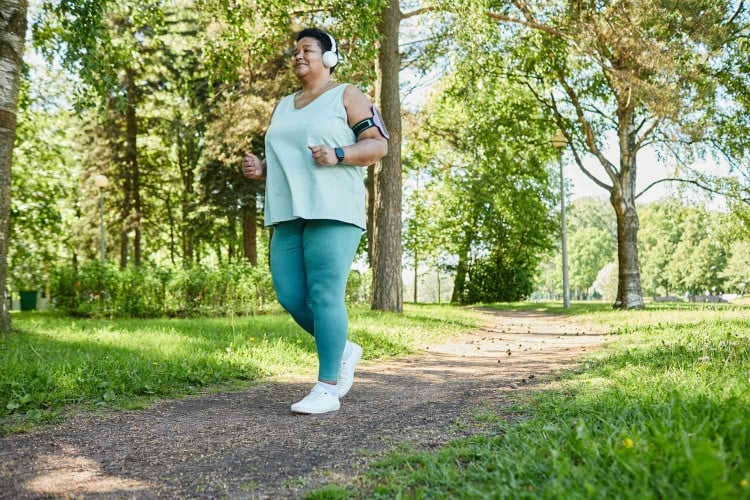- Research suggests that it may take far fewer than 10,000 steps a day to see health benefits from walking.
- Though walking is a very low-impact, low-risk activity, you still want to make sure you’re using the proper form to avoid any potential injuries.
- Proper body alignment, gait, and well-fitting sneakers are all important when beginning a walking program.

SeventyFour/Getty Images
Good news: It takes far fewer than 10,000 steps a day to reap the health benefits of walking, according to a handful of recent studies.
Though the exact number of steps varies—anywhere from 4,000 steps a day to 8,000 steps a few times a week—it’s clear that adding more movement to your day can pretty much guarantee some extra health benefits, including a reduced risk of dementia, cardiovascular disease-related death, and all-cause mortality.
If that news has you motivated to lace up your sneakers and hit the treadmill (or pavement), there’s one thing you might want to consider first: proper technique—or the “right” way to walk.
Though many people have been doing it since there were mere months old, the choices you make around walking—from your gait to what you put on your feet—can play a significant role in your health and well-being. Even where you walk can influence how you feel.
Here, experts break down strategies for making the most of walking—and avoiding injury along the way.
Focus on Proper Posture and Alignment
Whether you’re sitting, standing, or walking, posture is always important—but it doesn’t necessarily mean standing completely straight at all times; posture means maintaining the natural curves in your neck and back.
Some tips for maintaining proper posture and alignment while walking include:
- Stand tall. Pretend a string is pulling you up from the crown of your head, recommends Rusty Sarhan, CPT, an RRCA-certified running coach.
- Keep your head up, and don’t let it protrude in front of your body, which can stress your back or neck, said physical therapist Natalya Tronik, DPT.
- Focus on the path in front of you, keeping your eyes forward.
- Keep your shoulders back and down, and keep your arms relaxed and moving freely at your sides.
- Keep your abs tight and your pelvis neutral. Make sure your rib cage is aligned with your pelvis, and that your hips, knees, ankles, and second toe are also all in alignment, Tronik suggested. This can help you avoid straining your lower half.
Not only does this proper posture and alignment help you walk easier and prevent injury, it can also help you breathe and move more efficiently, Sarhan said.
Because it’s difficult to know what you look like while walking, Tronik recommends taking a picture of yourself in the mirror—or better yet, a video of yourself in movement—and making adjustments, if necessary.
3 Walking Workouts, According to Experts
Pay Attention to Your Feet
The proper step involves putting your heel on the ground first, then the ball of your foot, followed by your toes—it’s a rolling motion, Tronik said. This better helps to distribute the stress your lower body takes on while walking.
If you were to slam your entire foot down on the ground with a thud, that impact would “translate up the chain,” Tronik said, putting your knees, hips, and ankles at a greater risk of injury.
Walking cadence—or how many steps you take in a minute—matters too. Taking longer, less frequent steps may put more stress on your joints, while taking shorter, more frequent steps might feel easier on your body.
Additionally, a higher walking cadence—around 100 steps per minute—can be considered moderate-intensity exercise for adults, research shows. That means walking at that cadence or above will count towards the 150 weekly minutes of physical activity, recommended by the Centers for Disease Control and Prevention.
And while you might be tempted to walk in whatever you’re wearing on your feet at any given moment, your shoe choices are also important. Running or walking shoes are your best bets here, said Sarhan, because they’re typically lighter, have a cushioned heel, and support a person’s gait.
One thing you might want to avoid, however, is overly-supportive running shoes, said Sarhan. They can push feet outward and cause you to put most of your weight on the outside of your feet—something known as supination.
Even Just 4,000 Steps a Day Can Help You Live Longer, New Research Shows
Stay Alert and Take It Slow
Walking isn’t an inherently risky activity, of course—in fact, it’s “the easiest way to burn calories without any pressure on the joints,” according to Sarhan. Still, he and Tronik said there are some things to consider besides posture and gait before heading out for an excursion.
When walking outside, it can be easy to trip over things such as curbs, potholes, or uneven ground—especially in the dark. It’s essential to pay attention to your surroundings and, if necessary, to bring someone along to help mitigate risks, Sarhan said. (Taking extra precautions would likely be better than abandoning outdoor walks altogether, which research has found can boost cognitive function more than indoor walks.)
If you do decide to keep your walking inside on a treadmill, take precautions there, too. While it may feel secure to hold on to the treadmill handles, that will hinder your movement and workout. Instead, secure the treadmill’s safety clip to your clothing—if you lose your balance and somehow fall off the treadmill, the clip will trigger the belt to stop, preventing injury.
Tronik also advised taking it slow if you’re used to a more sedentary lifestyle. “Be mindful and actually set goals that are appropriate for your lifestyle,” she said. “If I haven’t walked in a year, I’m not going to walk for 10,000 steps right off the bat. I’m going to walk a mile and see how that mile feels.”
“Listening to your body is important for any fitness regimen,” said Tronik, “even one that is low impact, like walking.”
Related pages
Type 1 diabetes: Why adults are misdiagnosed with type 2 diabetes
Share on PinterestExperts say adults with type 1 diabetes are being misdiagnosed as having type 2 di

Hypertension: Eating dark chocolate may help reduce risk
Share on PinterestDark chocolate may have blood pressure-lowering effects, research suggests. Mike K

How to Deal with Diabetes Burnout
Mar 04, 2023 By Madison Evans Managing a chronic condition like diabetes ca

Proper Walking Form: Expert Tips on Posture, Foot Placement, Shoe Choice
Research suggests that it may take far fewer than 10,000 steps a day to see health benefits from wal

Marijuana Users Have Higher Levels of Heavy Metals in Blood, Urine
New research found heavy metals in the blood and urine of people who consumed marijuana.The two meta

Certain Cancers on the Rise in Younger Adults, Study Finds
New cancer diagnoses—particularly gastrointestinal cancers like colorectal and pancreatic—are on the

